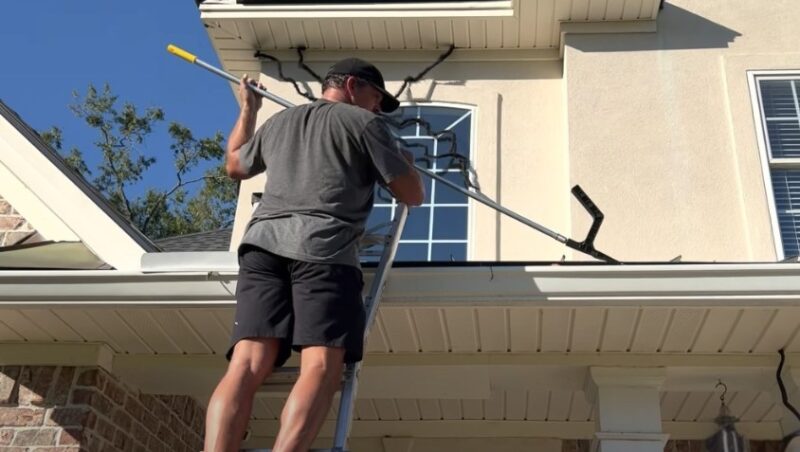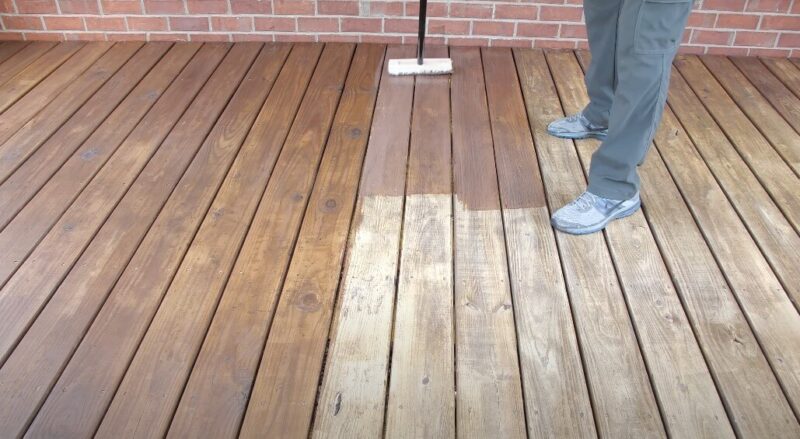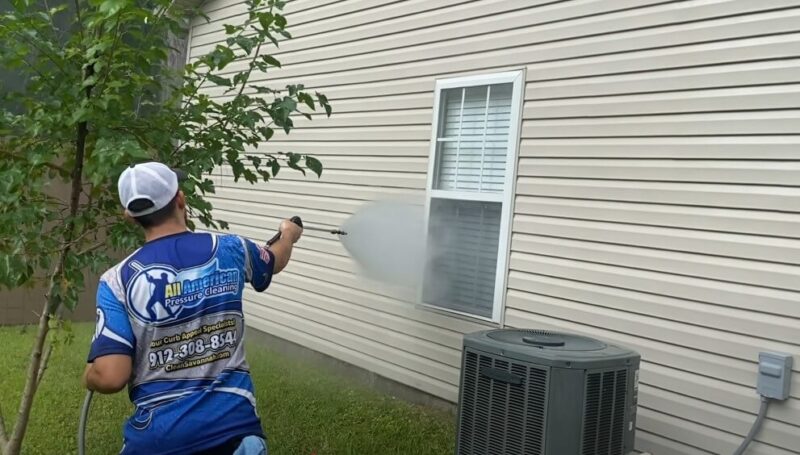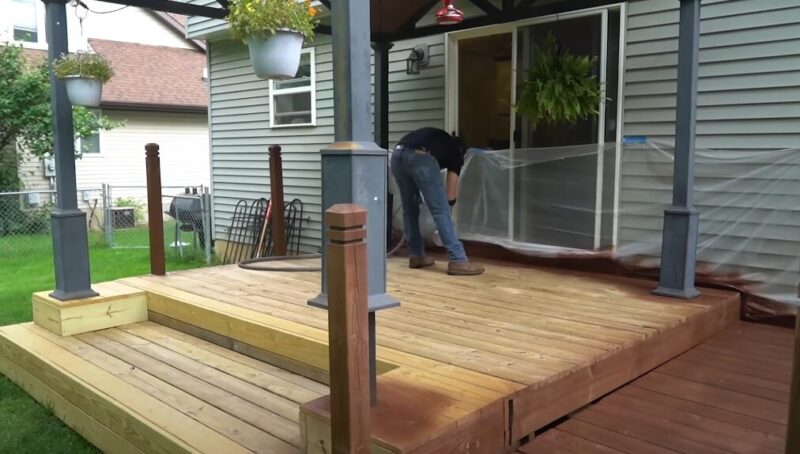Winter had its fun—icicles, hot cocoa, the whole cozy montage. Now the thaw reveals gunked‑up gutters and shingles hanging on like bad Wi‑Fi.
A smart once‑over now saves money, sanity, and maybe your hardwood floors come the first thunderstorm. Grab a sturdy ladder, a playlist that motivates, and let’s roll.
Quick‑Reference Cheat Sheet
| Task | Recommended Timing | Immediate Payoff |
| Gutter clean‑out | Each spring & fall | Stops fascia rot & basement floods |
| Roof scan | Early spring + post‑storm | Catches leaks before drywall stains appear |
| Sump pump test | Monthly in rainy season | Prevents ankle‑deep surprise in the basement |
| Weather‑strip check | Spring & pre‑winter | Lower energy bills, fewer drafts |
| HVAC tune‑up | Early spring | Cooler summer at lower cost |
| Foundation patrol | Twice yearly | Small cracks stay small |
| Deck/patio refresh | Spring clean & seal | Splinter‑free barefoot season |
| Lawn prep | Early spring | Thicker turf, happier plants |
| Dryer‑vent clean | Every six months | Reduced fire risk, faster dry times |
| Detector/ extinguisher test | Clock‑change weekends | Life‑saving seconds gained |
| Power wash exterior | Annually | Instant curb appeal |
| Outdoor tool service | Pre‑mowing season | Smooth starts, cleaner cuts |
1. Clear Gutters & Downspouts

Clogged troughs act like tiny swimming pools for leaves and pine needles, and that water will happily backstroke into fascia boards or your foundation.
A plastic scoop, a hose with decent pressure, and fifteen minutes per run of gutter usually do the trick. Pros from the GutterCleaning co suggest at least one spring cleaning—two if trees crowd the roof line.
Quick win: While you’re up there, tighten loose spikes so heavy June rain can’t yank gutter guards and the whole system down.
2. Scan the Roof From Ridge to Flashing
Binoculars earn their keep here. Look for curled shingles, popped nails, or shiny spots where granules washed away.
Flashing around chimneys and skylights calls for special attention; any gap becomes a VIP entrance for leaks. Early patch work beats interior drywall surgery every time.
Pro move: Snap phone photos of questionable areas—roofers love evidence when you ask for a no‑pressure quote.
3. Give the Sump Pump a “Rain‑Dance Rehearsal”
Pour a bucket of water into the pit and watch. The float should rise, the pump should kick on, then water ought to exit via the discharge line.
Silence or sluggish draining signals trouble—and that’s way cheaper to fix now than mid‑deluge.
Keep it happy: Clean the grate covering the intake so silt doesn’t gum up the works.
4. Seal Up Windows & Doors
Run your hand along the jamb during a breezy day; any flutter of cool air means energy dollars heading for the horizon.
Replace cracked weather‑strip tape, add fresh caulk where framing meets siding, and you’ll feel the payoff in lower utility bills all summer.
Bonus perk: Tighter seals shut down invading carpenter ants before their annual house‑shopping spree.
5. Tune Up HVAC Before Heat Waves Hit

Energy Star reminds homeowners to swap filters monthly in peak months, hose off condenser coils, and book a licensed tech for refrigerant checks.
Even a half‑clogged filter bumps energy use, so treat filters like toothbrushes: cheap, vital, and replaced often.
Rule of thumb: If the outdoor unit sounds like an 80s hair‑metal amp, call a pro—good HVAC hums, it doesn’t shriek.
6. Walk the Foundation Like a Detective
Hairline cracks? Note the length and revisit monthly. Wider gaps or stair‑step patterns in masonry need a structural engineer sooner than later.
Early filler injections run hundreds; ignored fissures can top five digits once settling snowballs.
7. Refresh Decks & Patios

A stiff scrub with oxygenated cleaner removes winter slime from your deck. Replace popped nails with coated deck screws, sand splinters, then seal bare wood before July UV rays bleach it beige. Concrete patios love a mild detergent followed by a clear masonry sealer for stain resistance.
Safety first: Wiggle railings—the only kind of wobble guests enjoy is in a cocktail.
8. Rally the Lawn & Garden Crew
Rake stray leaves so tender grass blades see sunlight. Aerate compacted soil if shoes feel like walking on pavement.
Test irrigation zones; a single clogged head can create a mud pit on one side of the yard while pansies faint on the other.
Hose health check: Pinch along rubber lines; cracks mean an imminent geyser when pressure builds.
9. Evict Lint From Dryer Vents

Lint is sneaky—it collects in elbows and corrugated sections where airflow slows, upping fire risk.
Unplug the dryer, pull the vent line, vacuum thoroughly, and replace damaged ducting with rigid metal pipe for smoother airflow.
Tell‑tale sign: If towels need two cycles, the vent resembles a clogged artery.
10. Test Smoke & CO Detectors (and Fire Extinguishers)
NFPA urges battery swaps at least yearly; chirping alarms mean change them now, not “later when I remember.”
Replace any detector older than ten years—the sensor fades even if it looks mint. Check gauges on extinguishers; needles should sit in the green.
Micro habit: Keep spare nine‑volts in the same drawer as coffee filters—you reach for those daily, so you’ll spot low inventory fast.
11. Power‑Wash Exterior Surfaces

Siding, walkways, and driveway stains vanish under 1,800–2,000 PSI. Start at a low‑pressure tip to avoid gouging wood or vinyl.
Add a mild detergent for moldy spots; rinse from the bottom up to prevent streaking, then top down for a final polish.
Curb‑appeal math: One Saturday, one rental washer, and you add instant “wow” every time you pull in from work.
12. Service Outdoor Power Gear
Consumer Reports’ checklist reads like a spa day for mowers: change oil, swap spark plugs, sharpen blades, and top off fresh fuel.
Those steps boost performance and extend engine life. Don’t forget string trimmers and edge clippers—dull line tears stems instead of slicing, stressing grass.
Storage hack: A dab of fuel stabilizer in late autumn keeps carburetors from gumming, making next spring’s first pull way less sweaty.
Wrapping up
A solid Saturday or two dialing in those dozen jobs beats summer surprises like standing water in the living room or an AC unit coughing warm air on the year’s hottest night.
Treat the checklist as a yearly tradition—pair it with your first iced coffee of the season—and your home will reward you with fewer repairs, lower bills, and bragging rights when neighbors wonder why their shingles shed like a husky.
Now crank up the playlist, pull on gloves, and show Winter the door—along with all the mess it left behind.

